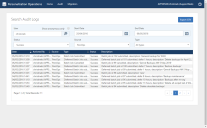This page refers to an older version of the product.View the current version of the online Help.
Audit Logs
In the Audit page, you can search for the audit record using some or all of the filters. You can also export audit information. The audit record to which you have access depends on your role.
For more information, see Roles.
In this section:
- About Audit Logs
- Search Audit Logs
- Set an Expiry Period for Audit Logs
- Delete Audit Logs
- Export Audit Logs
About Audit Logs
In the Audit page, you can view audit records for Personalization Operations events. When you first access the page, all audit logs for which you have viewing rights are visible. The logs are listed in a table with the following columns:
| Name | Description |
|---|---|
| Date | The date and time the event took place. |
| Actioned By | The Personalization Operations user who submitted the task. |
| Source | The tool or utility that performed the actions, such as Personalization Operations or the bulk processing of multi-user operations. |
| Type | The type of action or event, such as creating backups or deleting settings. Types also include messages generated by Personalization Operations in response to user actions, such as Batch Job Submitted or Batch Job Defer Changed. The bulk processor produces records about jobs starting and completing, and error messages are also recorded. |
| Status | Statuses are Success, Warning, and Error. The system has only one warning. If a batch job completes and less than 50% of users have a succeeded or partially succeeded status, the Success is changed to a Warning. |
| Description | A description for a single-user task contains
a description of the task and the user whom it affected. For example: Created backup for 'Graphics Application Group' for user 'GraphicDesigners\JohnSmith' Descriptions for completed multi-user operations (batch jobs) contain a number of statistics: For example: Job 81 (create backup) complete. Users: selected 853, succeeded 852, partially succeeded1, failed 0, retries 0
|
Search Audit Logs
Search the records using filters, which include a username, a date range, status, source, and type.
- In the navigation bar, click Audit to access the Audit page.
- To search for records related a specific user, enter the leading characters of the username in the User field and click the Search icon.
- Select Show anonymous only to show all events by anonymous users.
- To specify a date range for the records, by selecting a Start Date and an End Date in the date pickers.
- To filter by status,
select one of the following from the Status
drop-down list:
- Success
- Warning
- Error
- Specify the source
of the record by selecting one of the following from the Source
drop-down list:
- Batch processing
- Endpoint Self-Service Tool
- Personalization Operations
- Select the type of operation logged in the record from the Type drop-down list.
- You can select multiple types at a time. Examples
include:
- Create Windows Setting Backup.
- Restore Backup.
- Update Registry File.
Delete Registry Key
As you select filters, the audit records in the results table change to reflect your selection.
Set an Expiry Period for Audit Logs
- Specify the time period (in days) for which audit records are kept.
- Enter the time period in Days to keep audit records.
-
Click Save.
A success message displays.
Delete Audit Logs
Remove the audit logs that fall within a date range.
-
Click Delete Audit Range.
The Delete date range from audit logs dialog displays.
- To specify a date range, use the date pickers to select Date from and Date to values.
-
Click Confirm.
A confirmation dialog displays.
- Click Confirm.
Export Audit Logs
When you have refined the list of audit logs, you can export the record by clicking Export CSV. This downloads a comma separated value (CSV) file of the information on screen.
